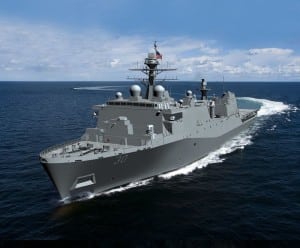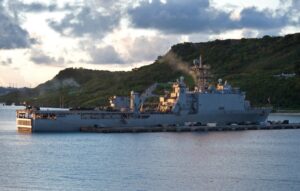This week the Marine Corps’ top official confirmed he added another amphibious ship to his fiscal year 2024 unfunded priorities list because the Navy budget plans to decommission three older amphibious ships without concrete plans to procure more over the next five years.
The Navy’s FY ‘24 budget request proposes the early decommissioning
of three Whidbey Island/Harpers Ferry-class dock landing ships: USS Germantown (LSD-42), Gunston Hall (LSD-44), and Tortuga (LSD-46). However, at the same time, the budget included no plans to procure more San Antonio-class Flight II amphibious transport dock ships to replace them, as originally planned (Defense Daily, March 13).

“For my role, as defining what the requirements are and the statutory minimum of three [amphibious ships], there’s no plan to get there. So from my perspective, I had to, I didn’t see any other way than to put [LPD-33] on the unfunded list in order to reflect that there’s no plan target to the minimum requirements,” Gen. David Berger, Commandant of the Marine Corps, said during a March 28 hearing before the Senate Appropriations Committee’s defense subcommittee.
The Marine Corps’ FY ‘24 unfunded priorities list named the LPD-33 Flight II San Antonio-class amphibious transport dock ship as the top priority at a cost of $1.71 billion (Defense Daily, March 21)
Berger warned if the Marine Corps does not retain at least 31 amphibious ships, the risk is that the “inventory atrophies to a point where we cannot deter, can’t campaign, can’t respond. And as I tried to highlight, when we can’t respond when we have to, then our allies and partners’ trust goes down and in all likelihood the way the Chinese Navy is growing and they’re expanding, they are liable to try to step in and we can’t afford to let that happen.”
In his written statement to the subcommittee, Berger argued the U.S. “cannot overlook the fact that since 2019, the People’s Liberation Army Navy (PLAN) has launched three Type 075 “LHA-like” and three Type 071 “LPD-like” amphibious warfare ships. The PLAN intends to launch an additional five Type 075 ”LHA-like” amphibious warfare ships in the next five years. It appears that the PLAN sees amphibious warfare ships as highly relevant and a critical instrument in power projection as evidenced by their recent deployments extending beyond the South China Sea.”
He also argued there is a “soft power component to our amphibious warfare ships that cannot be replaced by other platforms” and it is obvious China is learning the lessons and pursuing their own amphibious ships “as a competitive act.”
Berger also repeated his recent argument that the cost of the newest LPDs is actually clearly going up.
“As evidenced by constant year cost, the LPD Flight II is the most effective and affordable answer until a follow-on amphibious warfare ship is developed,” he said in the written statement.
Earlier this month, Chief of Naval Operations (CNO) Adm. Mike Gilday confirmed last year the Office of the Secretary of Defense (OSD) decided to pause the LPD procurement and do a study whether to continue buying them or shift to another variant due to increasing costs. However, Berger disagrees another study is necessary and that when using a different price comparison the newest LPD Flight II ships are going down in cost compared to older Flight I vessels (Defense Daily, March 15).
Berger also repeated many of these points during a hearing before the House Appropriations Committee’s defense subcommittee on March 29. He emphasized there is “no plan to procure LPDs. So as the requirements person for the nation in terms of what amphibious ships requirements must be – with that divestment it would drive our inventory down to 27 ships in a couple of years.”
Berger added that while an America-class amphibious assault ship under construction is due in several years, the amphibious force would still fall to 24 ships in the near to medium term under the current plans.
“We can’t do our job at 24 or 27. 31 is the bare minimum so that’s why [LPD-33] is on the list.”
During a separate hearing before the Senate Armed Services’ Seapower subcommittee on March 28, chairman Sen. Tim Kaine (D-Va.) said he thought Congress and the Defense Department were on the same page for maintaining a floor of 31 amphibious ships.

“Everybody made such a good case last year that we’re on the same page and the number’s 31 that I kind of wonder about – well what’s the continuous review of whether 31 is the right number, can you explain that?”
Jay Stefany, Acting Assistant Secretary of the Navy for Research, Development, and Acquisition, responded that the Secretary of the Navy, Commandant of the Marine Corps and Chief of Naval Operations still agree 31 amphibious ships is the requirement and repeated the Navy Department’s argument that given the last LPD is being procured in FY ‘23 the next one does not need to be purchased until FY ‘25 to keep an optimal production pace.
“So there is a period where we can look at a more affordable way of, potentially, to build those. We don’t need to build 1 in ‘24, we can take some time to see if there’s a more affordable way to build those before we buy the ’25 ship,” Stefany said.
Vice Adm. Scott Conn, Deputy Chief of Naval Operations for Warfighting Requirements and Capabilities, said this pressure is the effect of decades of focusing on land conflicts in the Middle East.
In the 1990s the older LSDs had their expected service lives changed from 35 to 40 years, assuming normal operations with six-month deployments fully funded maintenance.
However, “war on terror, we operated those ships much longer than in six-month deployments and we know we didn’t put the resources to those ships to be able to sustain them. So now we’re at a position where we have some hard choices to make,” Conn said.
Conn argued the Navy does not have the confidence the three LSDs being cut can complete the maintenance phase and go through their year-long workup cycles to get on deployment within their remaining expected service lives.
“If we can’t get them away from the pier, in the time that we have, and really this is about opportunities. Do we want to, from the cruisers and LSDs, to buy them back would be about $3 billion. Is that the right thing to do with that $3 billion?”
Conn said from the Navy’s perspective looking hull by hull, “those ships answer no.”
He said if the three LSDs are decommissioned there could be opportunities to free up space in the shipyards to do other work and for sailors assigned to the ships to go to sea on other vessels “and start buying down some of the significant gaps at sea that we have. So those are the opportunities and those are some of the tough choices – it was tough choice for us and I realize it’s a tough choice for you.”
When pressed by Sen. Mazie Hirono (D-Hawaii) on the LPD issue and why the Navy needs to conduct another study on top of 121 previous studies, Conn noted it was directed by the Office of the Secretary of Defense (OSD).
“OSD directed, as part of a cost capabilities study for the LPDs. We will have that study, we will complete that study and that will inform the presidential budget ‘25 shipbuilding plan.”
Stefany said the previous studies she cited focused on requirements for amphibious ships, while this study “is now I know I have to build that ship, now what is the most affordable way to build it, that’s what this one’s looking at. It’s not looking at requirements, it’s looking at – an LPD costs $1.9 billion, is it maybe there’s a way to build it for a little bit less, and still meet the requirements of the Marine Corps,” he said.
“It’s not a requirements study, it’s a cost study, if you will,” Stefany said.